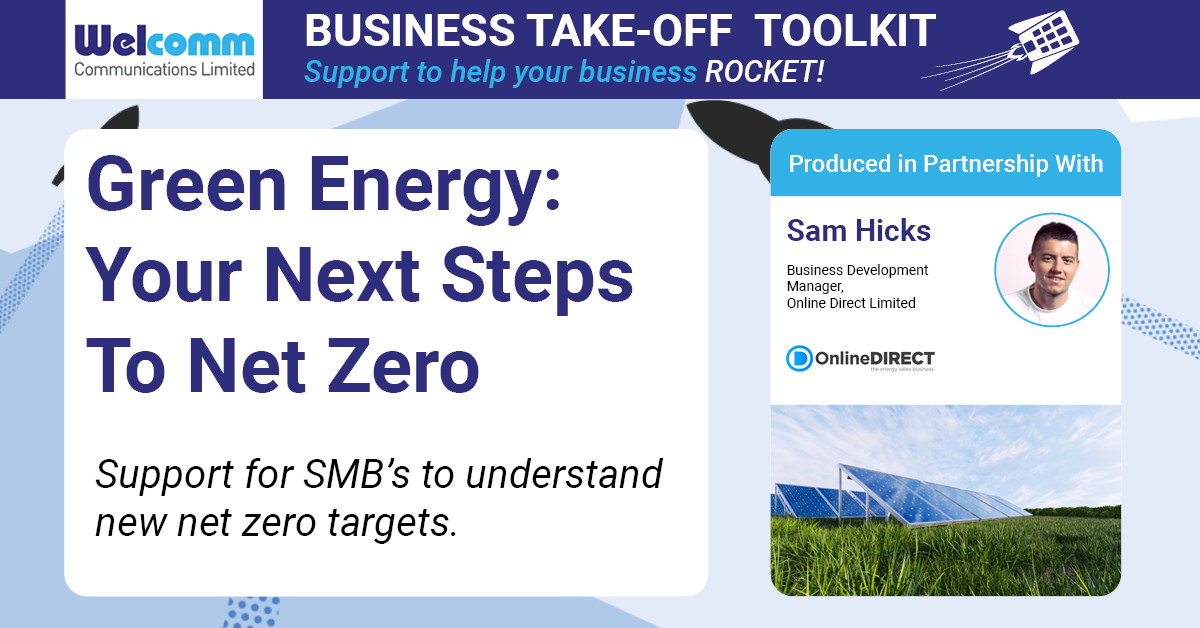

Initially legislation was set in the UK to commit to net zero emissions by 2050. Now going ‘net zero’ doesn’t necessarily just mean cutting emissions down to nothing… Things like generation or offsetting are likely to contribute in parallel with reducing emissions. However the UK government then later revised this legislation, and has now set the worlds most ambitious climate change target: to reduce emissions by 78% by 2035 in comparison to 1990 level.
If your business is looking for advice to work towards net zero targets, use the links below to quickly navigate through the video.

We first need to become more efficient with our energy use. That starts with monitoring our consumption, and having better technology to help us do that – something Welcomm can support with. Being able to control and reduce our usage more effectively is made possible by replacing outdated electrical appliances with more up-to-date technology.
Another important area is behavioural and societal changes. I think we all need to educate ourselves better around the impact and the sustainability of everything that we do.
Something that’s been in the news more often recently is the electrification of transport and heating. We’ve seen news about the banning of petrol/diesel cars and the introduction of electric vehicles, which will play a huge role. Another item that’s not had as much mainstream media attention is hydrogen, and the role that hydrogen will play to replace natural gas, as well as the role it can play with transportation too.

Surveys with small-medium businesses (SMB’s) show that most don’t know where to start when it comes to reducing their emissions. In fact, some survey results suggest that anything up to 40% of businesses are unsure of how to prepare for this shift. In truth, it’s unlikely to be a priority for SMB’s at the minute, particularly off the back of the global pandemic.
However, what I would say is with high energy prices driven by rising commodity markets, this really should be a driver for businesses to want to use less and be more efficient with their consumption – even if it’s not from an environmental perspective, but just from a cost saving perspective!
The most likely short-term effects will be operating supply chains in my opinion. Larger businesses and government tenders will likely all expect sustainability commitments from SMB’s in the near future and if they don’t comply, they might miss out on trade – so that’s probably going to be the greatest threat, particularly in the short term.

It’s a common saying, but if you can’t measure it you can’t manage it. That is why, I’d say the most important thing is to have a really good understanding of your emissions as a business, which can be broken down into scope one, scope two and scope three emissions. No business can improve without understanding how and where it emits.
Secondly, I’d suggest looking at your largest emitting areas, to really focus on how you might be able to make the biggest impact – so for example, for one business it might be transport and another might be it’s energy… really focus on that largest emitter to understand what strategy offers the greatest commercial benefit.

I think firstly, we can all make a difference by becoming more aware and educating ourselves about sustainability as a whole. It’s really important – as is understanding what personal impact we are having on both our local and national environment.
My second point would be, something we hear about quite a lot, and that’s us using and consuming less – flying less, driving less. If we reduce all of those things personally, that’s going to have a big impact overall.
Privacy Policy | Terms & Conditions
Copyright © 2022 Welcomm Communications Ltd - all rights reserved
Company Registration Number: 03815160
<link type=”text/css” rel=”stylesheet” media=”screen” href=”https://xmpp-contact.unlimitedhorizon.co.uk/resource/webchat/client/converse.css” />
<script src=”https://xmpp-contact.unlimitedhorizon.co.uk/resource/webchat/client/converse.js“></script>
<script src=”https://xmpp-contact.unlimitedhorizon.co.uk/resource/webchat/client/emojis.js“></script>
<script>
window.webchatConfig = { accessName: “WebchatTest”, postfix: “wcdcom-61015”,
chatComponent: “tcc”, xmppDomain: “xmpp-contact.unlimitedhorizon.co.uk”,
language: “en”, autoOpenTime: “10”,
BOSHServiceURL: “https://xmpp-contact.unlimitedhorizon.co.uk/resource/webchat/bosh/bosh“,
primaryColor: “#31b3e8”, titleText: “Welcomm Live Chat”,
assetsPath: “https://xmpp-contact.unlimitedhorizon.co.uk/resource/webchat/client/“}
</script>